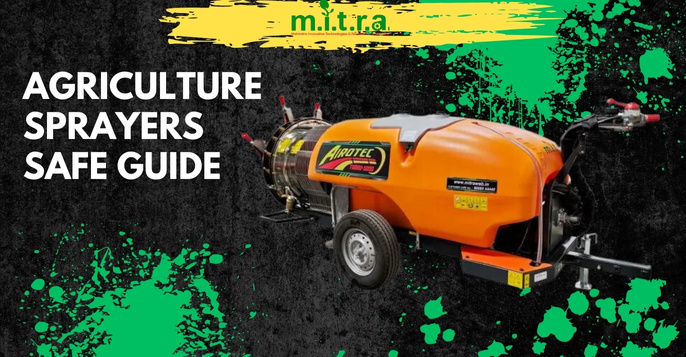If you’re a farmer, you know that agriculture sprayers are like superheroes in modern farming! From low-volume sprayers to agriculture mist blowers, they come in various forms designed to help you effectively apply pesticides, fertilizers, and other essential chemicals to your crops.
But just like any powerful tool, it’s important to know how to use it safely and efficiently.
Continue reading as we share some practical tips on how to make the most of these mighty machines while optimizing their effectiveness in pest management.
Efficient Ways to Use Agriculture Sprayers
Explore some efficient ways to use agriculture sprayers, so you can optimize your spraying practices and achieve the most effective results for your crops.
Choose the Right Sprayer and nozzle
Selecting the appropriate sprayer for your specific farming needs is the first step in ensuring safe and efficient use. You might consider factors such as the size of your farm, crop type, and the specific chemicals you will be applying.
Low volume sprayers are ideal for small farms, while agriculture mist blowers and tractor blowers are suitable for larger farms. Agriculture sprayer machines may be used for specialized applications. Choosing the right sprayer type will help optimize chemical applications and minimize waste.
Similarly, selecting the correct type and size of nozzles is critical for ensuring efficient and accurate application. Nozzles determine the droplet size and spray pattern, which can affect the coverage and efficacy of the agrochemicals. It is essential to match the nozzle type and size to the specific requirements of the agrochemical being applied and the crop being treated. Consult the agrochemical label and seek advice from agricultural experts or agronomists to make the right choice.
Follow the Manufacturer’s Instructions
It is essential to carefully read and follow the manufacturer’s instructions and guidelines for your sprayer model. This includes proper assembly, maintenance, and operation of the sprayer. Pay attention to settings such as nozzle type, pressure, and flow rate as recommended by the manufacturer to ensure efficient and effective application. Properly understanding and implementing the manufacturer’s instructions will result in safe and reliable sprayer operation.
Get FREE Consultation Today!
Talk Expert
Wear Proper Protective Gear
Personal protective equipment (PPE) is critical when operating agricultural sprayers. Wear appropriate protective clothing, such as long-sleeved shirts, long pants, chemical-resistant gloves, goggles, and a respirator, to protect yourself from exposure to chemicals and reduce the risk of respiratory, dermatological, or eye-related health hazards. Safety should always be a top priority when using agricultural sprayers. The following PPE should be worn when using sprayers:
- Chemical-resistant gloves
- Respirator or mask
- Eye protection
- Long-sleeved shirt and pants
- Chemical-resistant boots
Calibrate Your Sprayer
Calibration is a crucial step in achieving accurate and efficient application of chemicals. Regularly calibrate your sprayer by checking the nozzle flow rate and adjusting the pressure accordingly. This will help prevent the over or under-application of chemicals, which can result in uneven coverage or reduced efficacy. Proper calibration ensures that chemicals are applied at the right rate, optimizing their effectiveness while minimizing waste.
Failure to calibrate the sprayer correctly can result in under-application or over-application, both of which can have negative consequences on crop yield and environmental safety.
Consider Environmental Factors
Environmental factors play a significant role in the safe and efficient use of agriculture sprayers. Avoid spraying on windy days to prevent drift and potential damage to neighboring crops, water bodies, or wildlife. Be mindful of temperature and humidity conditions, as they can affect the efficacy of certain chemicals. Properly considering environmental factors ensures that chemicals are applied effectively, minimizing any adverse impact on the environment.
Follow Integrated Pest Management (IPM) Practices
Integrated Pest Management (IPM) is a sustainable approach to pest management that promotes the responsible use of chemicals. Incorporate agriculture sprayers as part of an IPM program by combining them with other pest management practices, such as crop rotation, biological control methods, and cultural practices. This integrated approach helps optimize pest control while reducing the reliance on chemicals and minimizing their impact on the environment.
Maintain Equipment Regularly
Proper maintenance of agricultural equipment is critical for safety and performance. Regularly inspect the sprayer for damage, wear, and leaks, and replace any defective parts. Ensure that all safety devices, such as emergency shut-off valves and pressure relief valves, are in good working order. Properly store and clean the sprayer after use to prevent chemical residue buildup.
Conclusion
Using agricultural sprayers safely and efficiently is essential for protecting the health and safety of farmers, farmworkers, and the environment.
We hope this blog provided valuable insights into how to safely and efficiently use agricultural sprayers.
By following these tips, farmers can make the most of their sprayers while minimizing risks and maximizing crop protection.
Farmers should carefully select the right sprayer for their specific needs, follow the manufacturer’s instructions, wear proper protective gear, regularly calibrate the sprayer, consider environmental factors, and integrate it into an IPM program.
Remember, safety should always be the top priority when using agricultural chemicals, and responsible and sustainable practices will lead to a better future for farming and the environment.
